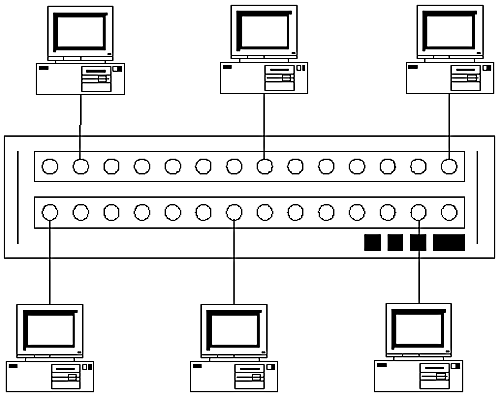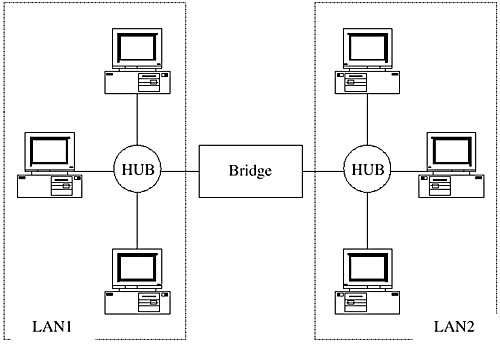27.2 Network Hardware Components
| |
27.2 Network Hardware Components
Besides servers and workstations, other hardware components take part as building blocks of a network. Some network components are explained here.
Network Cables
Different types of cables and connectors are used in the physical layer of a network. The selection of a cable determines the data transmission speed and the length of a single cable segment.
COAXIAL CABLE
Coaxial cable consists of a center wire and a cladding that surrounds the center wire. A dielectric material is placed between the two that acts as an insulator. Plastic is used to cover and insulate the cable. Coaxial cables are end terminated . BNC connectors are used to connect coaxial cables to each other and to network interface adapters. BNC connectors will be discussed in more detail later in this chapter. Coaxial cables support data transfer speeds of up to 10 Mbits per second.
TWISTED PAIR CABLE
Twisted pair cable is used in many Ethernet and token ring networks with RJ-45 or 9-pin d-type connectors. Twisted pair cable is either shielded or unshielded . Different cable categories are used with different standards of twisted pair cable, where each category is capable of handling a specific bandwidth. The most commonly used twisted pair cables are category 3 and category 5. Category 3 twisted pair cable is used for data transfer speed of 10 Mbits per second, and category 5 cable is used for speeds of 100 Mbits per second.
FIBER OPTIC CABLE
Fiber optic cable is made of glass, and data transmission takes place using light instead of electrical signals. Fiber optic cable is capable of very high bandwidths and is used for high-speed networks. Typically, this cable is used in FDDI and gigabit Ethernet networks. Data transmission speed of up to 1 Gbit per second is used in a gigabit LAN. Fiber cable is expensive and difficult to install. It provides excellent reliability for data transfer.
Selection of a specific type of cable depends on factors like cost, ease of installation, transmission speed, and reliability of data transfer. The cost of selecting a specific type of cable is reflected in other network components, such as hubs and switches. For example, if you use fiber optic cable, you have to use more expensive network interface adapters and switches.
Network Interface Adapter
A network interface adapter is installed inside a server or workstation. It is the connection point for a network cable to the host. HP provides different LAN adapter products, such as LAN/9000, Token Ring/9000, and FDDI/9000.
Cable Connectors
Cable connectors are used to connect cables to network interface adapters. Some of the cable connectors available with HP networking products are as follows .
BNC CONNECTORS
BNC connectors are used with coaxial cables. A BNC connector is built into the network interface adapter.
LAN-TP CONNECTORS
This type of connector is used with twisted pair cable. The socket is built into the network interface adapter. This is used to connect a network adapter to a hub or switch by using an RJ-45 connector.
AUI CONNECTORS
An attachment unit interface (AUI) is a 15-pin connector used to connect a network interface adapter to a thin or thick coaxial cable, twisted pair cable, or fiber optic cable with the help of a transceiver. A different type of transceiver is used for each type of cable.
Transceiver
A transceiver acts as a medium attachment unit (MUI) and its function is to connect a network interface adapter with a particular type of cable. It takes data from the network interface adapter and converts them into electrical signals suitable for the cable. A transceiver can be used to connect a network interface adapter to a coaxial cable, twisted pair cable, or fiber optic cable.
Repeaters
A repeater is a physical layer device used to regenerate electrical signals. In the case of long cables, the signal gets distorted due to noise as it travels a long distance over the cable. The repeater filters out the noise and regenerates the signal. Repeaters are used to increase the length of a cable segment. Figure 27-5 shows how a repeater reshapes the signal.
Figure 27-5. The signal regeneration process using a repeater.

Hubs
A hub is also a physical layer device. It is used to connect a number of hosts in the star topology. A hub provides many sockets or ports where network cables may be plugged in. Typical hubs contain 8, 16, 24, or 32 ports. Some manufacturers also provide hubs that can be stacked . A hub is shown in Figure 27-6, where hosts are connected to ports. Most modern hubs also provide network management features.
Figure 27-6. Cable connection using a hub.

If you are using a hub, an incoming data frame is replicated to all ports of the hub. Thus, every host connected to a hub listens to all data being sent on the network transmission media. A hub also functions as a repeater and is known in some literature as a multiport repeater.
Bridges
Bridges are devices that cover the physical and data link layers . They are used to connect LAN segments. A bridge can filter traffic depending on the MAC addresses of the source and destination hosts. Bridges help improve utilization of bandwidth available to a network by creating additional collision domains. A network without a bridge is a single collision domain. It means that only a single data packet can be transmitted over the network media at any time. In case two or more hosts try to transmit data frames, a collision occurs. The network shown in Figure 27-7 provides two collision domains because two hosts, one on each side of the bridge, can transmit data frames at the same time.
Figure 27-7. Bridge connecting two LAN segments shown as LAN1 and LAN2.

A bridge listens to the data frames on both sides and forwards a data frame to the other side only if it contains source and destination MAC addresses not on the same side of the bridge. Another advantage of the bridge is that it stops any error or collision to pass from one segment to another. It utilizes the store-and-forward method for this purpose.
Little or no configuration is required for a bridge. It automatically learns MAC addresses on each segment and builds its own table of MAC addresses to filter data traffic. Bridges work in the data link layer of the OSI model, and up to eight bridges can be used in a LAN in addition to repeaters.
Switches
Like a bridge, a switch operates in the data link layer and filters and forwards frames based on MAC addresses. Like a bridge, which is used to connect LAN segments, a switch is also used for this purpose and provides traffic filtering facility. In addition, if used in place of a hub, a switch may provide many parallel paths for data transfer, enabling many hosts to communicate simultaneously . A host is connected to one port of a switch. After receiving a data frame, a switch forwards it to only that port that connects to a host having a destination address equal to the MAC address of the host.
Any incoming data frame is not replicated on all ports of the switch (unless it is a broadcast). Instead, it is sent on a particular port depending on the destination MAC address in that data frame. A switch also works in the data link layer of the OSI model.
Routers
Routers operate at the network layer of the OSI model and are used to connect LANs and WANs. A router may filter and route traffic depending on network addresses (not MAC addresses). A router may use static or dynamic routing to send a data packet to a required destination.
In the lower three layers of the OSI model, routers are able to connect networks having different technologies. For example, a router can be used to connect an Ethernet network to an X.25 network. Routers use complex configuration tasks that require setting up traffic routing and filtering methods . A router can perform all tasks of a bridge and a switch.
Gateway
A gateway is capable of connecting completely dissimilar networks. It covers all layers of the OSI model. As an example, if you want to connect a Novell Netware LAN running on IPX/SPX protocol to a TCP/IP network, you need a gateway.
Table 27-1 lists network devices and the OSI layers covered by each device.
Table 27-1. OSI Layers Covered with Network Devices
| Network Device | OSI Layers Covered with the Device |
|---|---|
| Cable | Physical layer |
| Cable connector | Physical layer |
| Network interface adapter | Physical layer |
| Transceiver | Physical layer |
| Repeater | Physical layer |
| Hub | Physical and data link layers |
| Bridge | Physical and data link layers |
| Switch | Physical and data link layers |
| Router | Physical, data link, and network layers |
| Gateway | All layers of the OSI model |
| |
| |
| Top |
EAN: 2147483647
Pages: 390
- Context Management of ERP Processes in Virtual Communities
- Intrinsic and Contextual Data Quality: The Effect of Media and Personal Involvement
- Healthcare Information: From Administrative to Practice Databases
- A Hybrid Clustering Technique to Improve Patient Data Quality
- Relevance and Micro-Relevance for the Professional as Determinants of IT-Diffusion and IT-Use in Healthcare
- Chapter II Information Search on the Internet: A Causal Model
- Chapter III Two Models of Online Patronage: Why Do Consumers Shop on the Internet?
- Chapter IV How Consumers Think About Interactive Aspects of Web Advertising
- Chapter VII Objective and Perceived Complexity and Their Impacts on Internet Communication
- Chapter IX Extrinsic Plus Intrinsic Human Factors Influencing the Web Usage